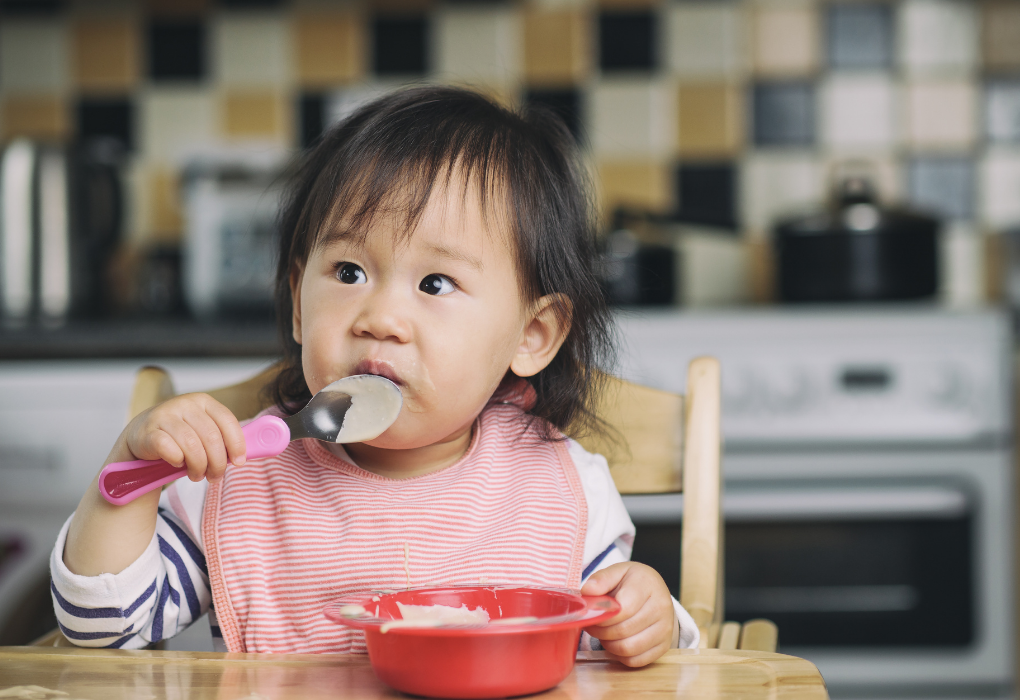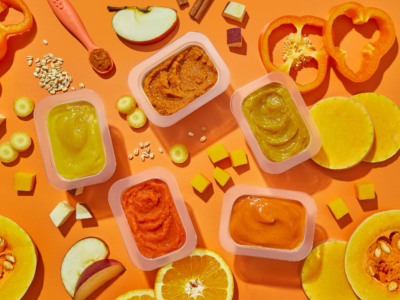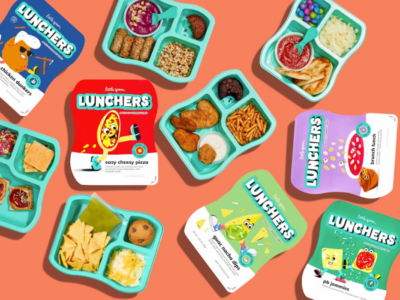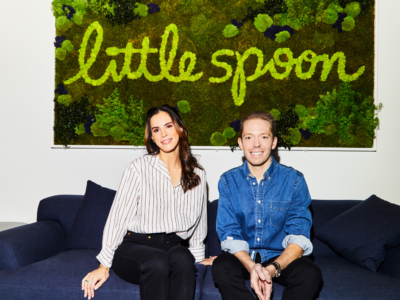Introducing new foods to your little one for the first time is an amazing journey—but it’s a confusing one, too. At Little Spoon, we’re all about making your life easier, and that means helping you navigate the overload of information that comes with parenting a newborn.
For the first few (exhausting) months of your little one’s life, all they need is breastmilk or formula to stay healthy and happy. But starting at around 4-6 months, your baby may start showing signs that they’re ready to transition to the exciting world of solid foods…and this is where the real fun begins.
Many families choose to follow the baby food stages, starting with single-ingredient purees and then moving on to more textured blends. Progressing through the baby food stages can help ensure your baby is exposed to the nutrients they need for each developmental stage and is exposed to a broad and varied diet to set them up for a lifetime of health.
Little Spoon takes the guesswork out of navigating this process with a rotating menu of blends developed by experts for each baby food stage, from single to multi-ingredient puréed Babyblends, to healthy, nutritious big kid Plates.
So, if you’re ready to start your baby’s solids journey, let’s walk through the three main stages of baby food, and bring on the good stuff!
Stage 1
Most babies are ready to enter the first stage of baby food at around 4-6 months. You’ll know your baby is ready to move into Stage 1 when they start showing interest in foods that their family is eating, can close their mouth around a spoon, and can hold their head up on their own when sitting in a high chair. While most families introduce solids at this time, it’s always best to check with your pediatrician before making any changes in your little one’s diet.
In Stage 1, you can start your babe on single-ingredient, simple, smooth foods. Think: thin, smooth purées, with absolutely no chunks. At Little Spoon, we’ve developed a whole line of single-ingredient, whole food Babyblends for this exciting first step in the solids journey. Some of our favorite Babyblends to start with: apple, pear, butternut squash.
Something to keep in mind: at this stage, these puréed solids should act as more of a supplement—your baby should still receive about 24 to 32 ounces of formula or breast milk each day. Remember: babies’ tummies are tiny! You shouldn’t feed them more than a few spoonfuls of solids (around 3-4 tablespoons—or half of a Babyblends container, 1-2x per day) at a time.
Stage 2
Between 6-9 months, most babies are ready for a bit more texture, but aren’t quite ready to chew solid chunks (even mushy ones!). This means it’s time to graduate to Stage 2.
Foods at this stage should still be mostly smooth and puréed, but you can now start introducing thicker consistencies and a bit of texture. Your baby is also ready to start getting introduced to a wider range of flavors and foods, including spices, so you can start combining more than one ingredient,
This means it’s the perfect time to graduate to Little Spoon’s more textured, puréed offerings, like our Carrot Apple Ginger, Sweet Potato Apple Blueberry Flax, or Kale Avocado Green Apple Chia Babyblends.
It’s actually advised to start introducing your baby to as many new food groups as possible at this stage, so this is a fun age where we like to get more creative with Little Spoon’s blends. Doing this early on can help prevent those pesky picky eating phases that tend to pop up amongst toddlers.
As your little one becomes more comfortable with eating more textured solids, you can increase the frequency and variety of their meals. By 8 months, this means your baby will likely be eating up to two meals per day. In terms of quantity, at this age, your baby should be eating around 4 ounces of solid food (conveniently, the size of one Little Spoon blend!) at each of their meals.
Stage 3
By 10 months, you can feed your baby nearly any food, as long as you make sure to cut it up into small, soft, chewable chunks (the mushier the better—this is not the time for al dente cooking!)
Some of Little Spoon’s tasty, more textured blends include Carrot Apple Buckwheat Cinnamon Pumpkin Seed Flax Oil blend or Quinoa Raspberry Pear Coconut Milk Vanilla Date Wheat Germ Oil blend.
At this stage, babies will be up to three meals per day, with snacks in between, so there will be plenty of opportunities to experiment with new foods, flavors, and preparations.
By the end of Stage 3, your baby will likely begin picking up food and other objects with a pincer grasp (using their thumb and forefinger), and may even try to use their spoon by themselves. These are usually signs that your little one is moving up to “big kid” status, and is ready to move into more finger food transitional foods—another exciting step, because it means they might be ready to try Little Spoon’s tasty and nutritious Plates.
Baby-Led Weaning & Transition Foods
Once your baby has mastered Stage 3, it’s time to begin considering the transition to finger foods. You may also end up skipping the spoon-fed purées and heading straight to mushy, cooked solids if you’re going the route of baby-led weaning, which involves letting your baby feed themselves (properly prepared, single-ingredient) finger foods like sweet potato, banana, or avocado at around 6 months old.
Little Spoon’s Plates are perfect for baby-led weaning and transitional, post-Stage 3 finger foods alike, with a little bit of modification for each case. For example, ever-popular Chicken Super Nuggets With Sweet Potato Carrot Tots are a perfect transitional food when the nuggets and tots are both chopped into small, baby bite-sized pieces.
If you’re looking for a more veggie-forward transitional meal, Little Spoon’s Broccoli Bites and Cauli Croquettes Plates are great for both baby-led weaning and as a way to transition from Stage 3 into more complex meals, because both veggie bites are already quite soft and easily mashable.
Parents also love the Mac and Three Cheese Plate as a way to sneak in some hidden veggies (there’s butternut squash and carrots in there!) with little ones transitioning to more textured solids—the soft, squishy nodules are perfect for baby-led weaning, too.
Overall, this will be a special time for you to learn more about your baby, and bond over exploring new flavors, textures, and combinations. We’re excited to help you set your baby up for a lifelong love of good food and sharing meals around the table—even after they graduate from the high chair.



